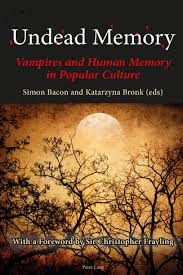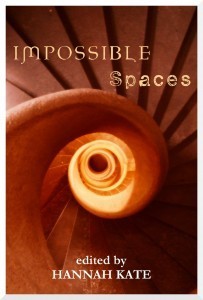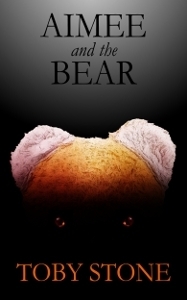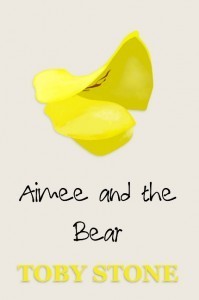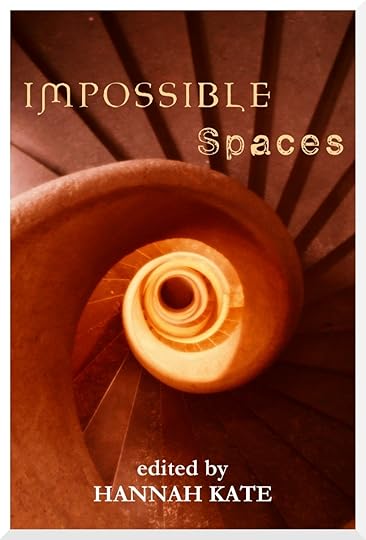Hannah Kate's Blog, page 77
February 16, 2014
OUT NOW: Undead Memory: Vampires and Human Memory in Popular Culture (Peter Lang)
edited by Simon Bacon and Katarzyna Bronk
foreword by Sir Christopher Frayling
I don’t normally write about my academic work on this blog (if you’d like to know more about it, you can read about it on my other blog), but I thought I would make an exception for my essay in this new edited collection on vampires and memory. Particularly as it lead to some interesting creative ideas…
When the editors (Simon Bacon and Katarzyna Bronk) asked me to write something for their proposed collection, I was a little resistant. I’ve written academic essays about vampires before, but my heart really belongs to werewolves (and, sometimes, fairies), and my intention was to carry on focusing on the lycanthropes. But then Simon suggested that I write about vampire/werewolf narratives, and I started to change my mind. In fact, he originally suggested that I write about the ways in which werewolves ‘are usually the familiars or pets of vampires’ or ‘the ways vampires are constructed as a superior race to werewolves’. This got my wolfish hackles up, and I immediately suggested that I should write about the texts in which werewolves are vampire-hunters or warriors – I was thinking particularly about McNair in Being Human and the Quileutes in the Twilight series.
So… I started working on my chapter, which was eventually titled ‘Pack versus Coven: Guardianship of Tribal Memory in Vampire versus Werewolf Narratives’. There’s more info about the book on the publisher’s website.
I’m not going to rehash all the arguments I make in my essay. What I thought I’d write about here is the creative project that followed on from writing this essay. One of the things that interested me as I worked through the narratives I was writing about was the consistency of the power relations presented. No matter whether the text was an action film (like those of the Underworld series), a TV drama (like Being Human) or a YA paranormal romance (like the Twilight series or Bree Despain’s Dark Divine novels), a particular and familiar hierarchy reappeared. Vampires are powerful, upper class, (hyper-)white, capitalist (and usually rich); werewolves are powerless (but often resistant), lower class, native, exist (sometimes) outside economic and societal hegemonies. Put more simply: vampires are the elite, werewolves are the underdogs. This leads us to be (usually) more sympathetic to werewolves, and to feel like they may be ‘right’, even when vampires are more attractive.
I asked friends and the Twitter hivemind about this, posing the question: ‘Can anyone think of a film/book/TV show with powerful (or ‘bad’) werewolves versus powerless (or ‘good’) vampires? The responses I received fell into three categories: (1) texts where vampires and werewolves live alongside humans, and there are a range of power dynamics and moralities at play; (2) texts where vampires and werewolves live alongside humans, and both are a dangerous threat; (3) texts where a vampire has become separated from its ‘correct’ status or lifestyle. None of these quite fit the model I was looking for.
At the same time as I was searching for my elusive good vampire/bad werewolf narrative, I was asked to contribute a short story for a new anthology (coming out some time this year). I was asked to write about ‘anything to do with monsters or monstrosity’. I decided to set myself the challenge of writing a good/powerless vampire vs. bad/powerful werewolf story. But I set ‘rules’ that both the vampire and the werewolf had to be recognizable (i.e. I couldn’t just flip the species and call a vampire a werewolf), and that the story had to have some reference to literary or folkloric traditions of werewolves and vampires.
I’m not going to say how I did it… the story is out later this year, and I’ll blog more about it nearer the time. You can see the traditions I’ve mashed-up to make my lower-class, powerless, vulnerable vampire vs. high-status, powerful, threatening werewolf when the book comes out.
But I’m still curious… can you think of any other narratives that do this? (I’m always open to new stories!) Or, if you were going to create this scenario, how would you do it? What traditions would you use to make a good vampire/bad werewolf show-down? Or do you think the power relations are too fundamental to mess with them?
I’d love to hear your thoughts on this!
November 9, 2013
November eBook Bargains
To celebrate the release of Blood and Water, the fantastic debut novel by Beth Daley, my publisher is having an eBook sale! All other titles are just 99p for the whole of November.
If you haven’t already, take this opportunity to get your hands on:
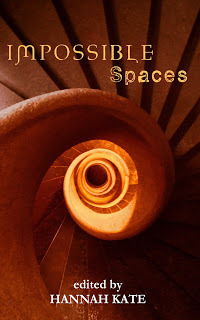
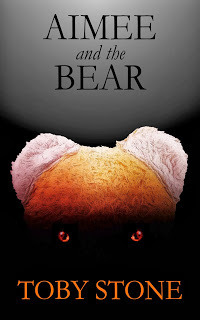
Wolf-Girls: Dark Tales of Teeth, Claws and Lycogyny
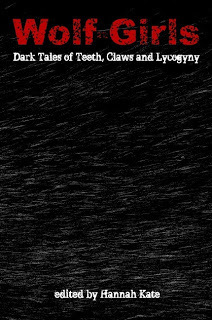
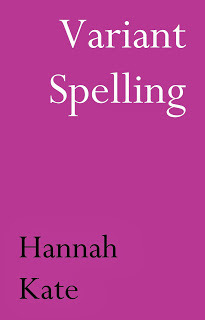
OUT NOW: Blood and Water by Beth Daley (Hic Dragones, 2013)
A plug for something I edited, rather than wrote, today. It’s a fantastic book, though, and you should definitely check it out…
Out now from Hic Dragones, the debut novel by Beth Daley: Blood and Water
Watch the trailer here:
Dora lives by the sea. Dora has always lived by the sea. But she won’t go into the water.
The last time Dora swam in the sea was the day of her mother’s funeral, the day she saw the mermaid. Now she’s an adult, a respectable married woman, and her little sister Lucie has come home from university with a horrible secret. Dora’s safe and dry life begins to fray, as she is torn between protecting her baby sister and facing up to a truth she has always known but never admitted. And the sea keeps calling her, reminding her of what she saw beneath the waves all those years ago… of what will be waiting for her if she dives in again.
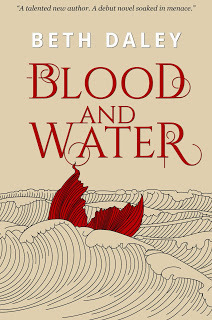
Praise for Blood and Water:
A talented new author with a feel for details and how to make them count. Daley’s writing is a cumulation of neat touches that grab hold of you, persuade you to care, and drag you deep into a debut novel soaked in menace. Toby Stone
For more information, or to order a copy, please visit the publishers’ website. Also available on Amazon.
October 21, 2013
Blood and Water Launch Parties (Manchester and Leeds)
Blood and Water
the debut novel by Beth Daley
Release Date: 7th November 2013
Publisher: Hic Dragones
For more information, visit the publisher’s website

Dora lives by the sea. Dora has always lived by the sea. But she won’t go into the water.
The last time Dora swam in the sea was the day of her mother’s funeral, the day she saw the mermaid. Now she’s an adult, a respectable married woman, and her little sister Lucie has come home from university with a horrible secret. Dora’s safe and dry life begins to fray, as she is torn between protecting her baby sister and facing up to a truth she has always known but never admitted. And the sea keeps calling her, reminding her of what she saw beneath the waves all those years ago… of what will be waiting for her if she dives in again.
Praise for Blood and Water:
A talented new author with a feel for details and how to make them count. Daley’s writing is a cumulation of neat touches that grab hold of you, persuade you to care, and drag you deep into a debut novel soaked in menace.
Toby Stone, author of Aimee and the Bear
Blood and Water Launch Parties
FREE EVENTS in Lancashire (Manchester) and Yorkshire (Leeds), our very own WAR OF THE ROSES! Join us for the launch of Blood and Water.
Thursday, 7 November 2013 from 19:00 to 21:00
Portico Library
57 Mosley St
Manchester M2 3HY
United Kingdom
Wine reception and readings by the author
Sell Tickets Online through Eventbrite
Friday, 8 November 2013 from 18:00 to 20:00
The Maven
1-3 Call Lane
Leeds LS1 7DH
United Kingdom
Event Registration Online for Blood and Water – Book Launch powered by Eventbrite
September 16, 2013
Guest Post: Jessica George
Another guest post today as part of the Impossible Spaces blog tour. I’m pleased to welcome Jessica George to the blog, author of the story ‘New Town’. Like a couple of the writers in Impossible Spaces, Jessica juggles two lives – as an academic researcher and as a fiction writer. Before she submitted a story for the anthology, I was only familiar with the former. I’d heard Jess give conference papers on her PhD research – which focuses on weird fiction, specifically Machen and Lovecraft.
I knew that Jess’s fiction was inspired by the writers she studies, so was expecting to see this in her Impossible Spaces submission. However, when I read her story, I was instantly impressed by the way in which she draws on this inspiration. Make no mistake: Jess’s writing does not read like Lovecraft’s! Her fiction has a down-to-earth quality – almost a breeziness – that is about as far from Lovecraft’s ponderous prose as you can get. ‘New Town’ combines this with precision and subtly that makes for a very compelling tale of a young woman drawn into the ever-present past of her hometown in Wales.
Despite the differences, though, Jess’s writing belongs to the same world as Machen and Lovecraft’s. In the case of Machen, this is kind of literal (and Jess will say a little more about this below). For these writers, the world is old – ancient, even – and, no matter how much they think they have done so, the people of the present can’t deny this for long. Something will always reach out eventually – and it might not be what you were expecting.
Anyway, time to hand over to Jessica…
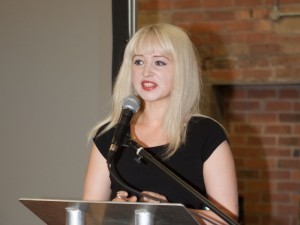 My name’s Jessica George. I’m a PhD student at Cardiff University, a library assistant, and a writer. My Impossible Spaces contribution, ‘New Town’, is the first story I’ve had published in a physical book, though my stories have appeared online on Every Day Fiction, The New Flesh, and Friction Magazine. (If you’re interested, they’re listed here. I’m hugely grateful to Hannah and Rob for including my story, and to Hannah for inviting me to guest post here.
My name’s Jessica George. I’m a PhD student at Cardiff University, a library assistant, and a writer. My Impossible Spaces contribution, ‘New Town’, is the first story I’ve had published in a physical book, though my stories have appeared online on Every Day Fiction, The New Flesh, and Friction Magazine. (If you’re interested, they’re listed here. I’m hugely grateful to Hannah and Rob for including my story, and to Hannah for inviting me to guest post here.
My PhD focuses on the work of Arthur Machen and H.P. Lovecraft, two writers whose works evoke a vivid sense of place – and my own writing has usually gravitated towards the fantastic, towards depicting a world in which the usual rules are a little bit different. I don’t think that’s unusual. Children’s literature, after all, is full of such places – from Narnia, to the secret den at the bottom of the garden where the rule of adults no longer applies.
For those of us who gravitate towards the otherworlds of SF, fantasy, and the weird, it’s a natural progression. Maybe it’s not too much of a stretch to say that the written world itself is an impossible space. The most mundane actions, objects, places, when a writer chooses to depict them, gain a significance they couldn’t ordinarily have. But that’s not to say that ‘real’-world places can’t themselves partake of the weird…
I now live in Pontypool (not the one from the horror film of the same name), but I grew up in the neighbouring town of Cwmbran.
As Buffy-obsessed Millennial teens, we christened it the Hellmouth, imagining, perhaps, some swirling vortex beneath McDonalds that attracted Kappa-tracksuited conformity like Sunnydale drew demons. There’s nothing unusual there; probably every sixteen-year-old of a slightly alternative bent imagines him- or herself alone against the zombie hordes in his or her hometown.
There is, however, something a little bit odd about Cwmbran.
A New Town established in 1949, it serves to this day as a destination for architecture students, who come to admire the mostly-unspoiled nugget of Sixties design that is the pedestrianized shopping centre – the closest thing the town has to a distinguishing feature. From the golden arches at one end to HMV at the other with hardly a non-chain retailer in between, Cwmbran is the clone town par excellence. (The tiny £2.50 fleapit cinema, something of a local institution, closed down recently, finally scuppered by the move from film to digital.) And it’s not just the shopping centre. My friends and I grew up in near-identical pebbledashed terraces, on developments each equipped with near-identical sets of local shops and near-identical family-oriented pubs. Nightlife in the town centre was, in the nineties, non-existent; at five thirty, the crowds abruptly vanished and the centre became a hollow, uncanny place, recast in echoing shadows and the life-sucking orange tinge of never-switched-off security lights.
Anyone who’s ever listened to the Slits’ ‘New Town’ will recognise this place, and its sense of provisionality – as will anyone with more than a passing acquaintanceship with horror cinema. Weather aside, there’s more than a passing resemblance between the new town and the kind of identikit American suburbia whose onscreen presence promises some imminent gory cataclysm. Plonked down on top of a hitherto rural landscape and psychologically fenced off from it, it’s just begging to be uprooted.
And there’s the crux of it. While modern Cwmbran may be a far cry from the area Machen once called an “enchanted land”, a place whose ancient hills and mystic woods hid antediluvian mysteries, it’s still populated by humans. And where human imagination exists, the weird will find a way.

© Copyright Robin Drayton and licensed for reuse under the Creative Commons Attribution-Share Alike 2.0 Generic Licence
There’s the single town-centre tower-block (now done up to look like a budget hotel) in whose lift last week I encountered a bloke in a dressing gown, slippers, and fedora, with a brandy-glass of rum in his hand. There was the (now sadly departed) Square Inn, whose combination of oddity of layout (bar, lounge… subterranean bowling alley?), welded-to-the-bar clientele, and a faint sense that you might get glassed if you looked at someone a bit funny led to its being nicknamed “the Star Wars bar”. There are spaces in-between the carefully-laid-out housing developments and pedestrianized malls where human beings will always overspill the bounds marked out for them.
I won’t go as far as Machen did, and credit the geographical space of my upbringing with my desire to write. But it might just bear some of the responsibility for my propensity for the weird, with its emphasis on the slipping-in of the strange by unexpected byways. One thing that New Towns perhaps do better than anywhere else is highlight the thinness of the boundaries between the very new and the very old, the expected and the unpredictable; the fact that everyday life is often incredibly mundane and really damn weird at the same time.
That, perhaps, is what I’m trying to get at in ‘New Town’. Its main character, Heledd, is a perfect clone town inhabitant. With little sense of self: her identity is constructed from consumer goods and the expectations of her family and colleagues. She’s vague and directionless, and yet, of the just under 50,000 people in the town, it’s she whom the past chooses to reach out and swallow. While the idea of an inviolable human self is a tricky one, she’s certainly unable to keep herself from finding – and eventually embracing – something more, something other. The business of creating a clone town may be fairly straightforward, but – I hope – creating clone people is a hell of a lot harder.
For more information about Impossible Spaces, or to buy a copy, please visit the publisher’s website.
September 1, 2013
Guest Post: Rachel Yelding
Another post on the Impossible Spaces blog tour. I’m pleased to welcome Rachel Yelding to the blog, with a post about her writing process.
Rachel’s story in Impossible Spaces is called ‘I’d Lock it with a Zipper’. In case you don’t recognize that phrase, it’s a line from the Tin Man’s song, ‘If I Only Had a Heart’, from the 1939 Wizard of Oz film. That should give you a little hint of what to expect from Rachel’s story – but I’d like to think it will still surprise you.
Rachel’s story is steampunk – and it has plenty of clocks and cogs and Victoriana for fans of steampunk style. But what I like about Rachel’s story is that it never sacrifices content for style. ‘I’d Lock it with a Zipper’ has a wonderfully dark and macabre heart – don’t be fooled by the sweetness of the Alice in Wonderland and Wizard of Oz influences. It is undoubtedly one of the more whimsical offerings to be found in Impossible Spaces, and I mean this as a compliment. I’m a huge fan of dark whimsy (think Jeff Noon’s Automated Alice, for instance) and love the unsettling juxtaposition of fairy-tale cuteness with brutality and pain.
Rachel’s background is in screenwriting, and this comes through in her writing. ‘I’d Lock it with a Zipper’ is a very visual story, and this plays to good effect in both the ‘cute’ and the ‘brutal’. But Rachel has managed to combine this eye for detail with a lively narrative voice and a talent for storytelling. I’m looking forward to reading more of her prose in the future.
Take it away, Rachel…
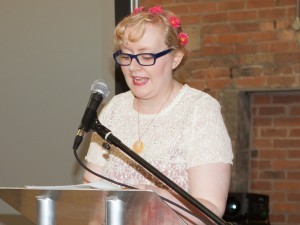 Hi! I’m Rachel, author of steampunk body horror, ‘I’d Lock it with a Zipper’. Hannah asked me to tell you about my writing process – I’ve already written about how to plan a story on my blog – so today I can talk more generally about how I write and especially how I wrote ‘I’d Lock it with a Zipper’.
Hi! I’m Rachel, author of steampunk body horror, ‘I’d Lock it with a Zipper’. Hannah asked me to tell you about my writing process – I’ve already written about how to plan a story on my blog – so today I can talk more generally about how I write and especially how I wrote ‘I’d Lock it with a Zipper’.
I write screenplays and graphic stories, this prose business is new to me – ‘I’d Lock it with a Zipper’ is my first attempt at prose since Creative Writing classes – but whatever I write I never start until I have an outline. An outline is a summary of the story I wish to tell featuring a beginning, middle and end. It can be something simple like a paragraph of basic ideas or a twenty page treatment (though I only ever write something THAT big if it’s for someone else to read). Having an outline of my story makes when I start writing so much smoother as I will have already encountered, puzzled over and pulled my hairs out over any big plot and character problems and hopefully sorted them out. Of course that is not to say that I won’t encounter more problems or decide to completely change a plot point once I get started (stories evolve as they are written and my finished works never look like their original jottings) but I’ve given myself some good foundations on which to build. With ‘I’d Lock it with a Zipper’ I think I wrote two pages of outline.
When writing a first draft (or what I like to call the ‘spew’ draft) I will read over what I wrote the previous day to check for big, obvious mistakes then try and get as much of the story out of my head and written down as I can. On a first draft I try to avoid heavily editing areas until I’ve written the whole story out. This is easy when the piece is short but very tempting to defy when the piece is feature/novel length; however I know too many people who never finish writing good stories because they have gone back to the same part and worked it over again and again and again until they can’t see the overall picture anymore. I write in my fashion for four reasons:
1) It feels a relief to get the whole story out of my system,
2) I will always be hooked up on the fact I haven’t finished my story if I keep working on the same section and this will distract me from doing the best edit I am capable of,
3) Until I have the whole story written out I won’t know how my problem scene fits into the overarching story,
4) I know the second draft is coming and that and all subsequent drafts are for editing.
Of course there are times when I too realise I can massively improve a previous section when writing a first draft. Usually I know when a section isn’t quite working and it will be on my mind (consciously and subconsciously). In that instance I will go back and make the changes – it will put my mind at ease so that it won’t be bugging me whilst I try to write the rest of the story – but I only ever do this with problem areas. Everything else waits for the editing stage.
I’m a visual person. When I’m thinking up scenes I see them as scenes from a movie rather than just words. It’s why I tend towards film and graphic stories. This means that my spew drafts can be overly detailed. In the first draft of ‘I’d Lock it with a Zipper’ EVERYONE had their clothing described… in painstaking detail… because at that moment I needed to write what I saw EXACTLY how I saw it or the image would be lost forever. Looking back I realised so much description wasn’t necessary to create the same visuals, but that’s fine – it’s always easier with writing to take away than to add more – and it’s what the next stage of writing is about… THE EDIT.
The edit is important. I’d never send an unedited piece of writing to anyone.
Spew drafts are easy to edit. I leave them for a couple of days/weeks then return to them and hopefully spot all the major, horrible, embarrassing mistakes and correct them. Then, when it’s looking in reasonable shape, I inflict my draft on someone I trust and hopefully they spot all the major, horrible, embarrassing mistakes I missed.
Much like not going back and seriously reworking a scene when I haven’t finished a first draft I find it is best to only seek a second opinion when I am done with my first draft (unless I’m very, very stuck). Any advice before then can be confusing however getting second opinions when I am ready is essential. Not only will others see the obvious things I was blind to but sometimes their suggestions will trigger whole new ideas that are just what was needed to make an okay story into a great story.
Hannah was a wonderful editor, correcting and suggesting without forcing. The scene where Dizzy tells Verity about the other robots had always gnawed at me but it was only when Hannah highlighted it for another reason that I realised why it niggled at me so – I was breaking the first rule of writing – I was telling rather than showing! Moreover I realised that there wasn’t even anything stopping Verity from experiencing one of the robots first hand… so I rewrote her first minutes in Clockwork. Thank goodness I did! Verity meeting the gramophone robot is one of my favourite scenes now! Not only did it make Verity’s introduction to Clockwork much more exciting but it hinted at what was waiting for her in Brother’s castle.
Though sometimes it might not feel it, editing is good.
Well, I hope you’ve enjoyed finding out how I write and I hope that some of it will help you write too!
To find out more about Impossible Spaces, or to buy a copy, please check out the publishers’ website.
Guest Post (and Reading): Toby Stone
Continuing my little flurry of guest posts… I am really pleased to welcome Toby Stone to the blog. As you may already know, I am Toby’s editor (and, while we’re at it, publisher) in my other guise as editor-in-chief at Hic Dragones. Earlier this year, we published Toby’s amazing debut novel, Aimee and the Bear, which is a unique, dark, twisted tale of a girl’s escape from an abusive home (with the help of an unforgettable teddy bear).
Aimee and the Bear is not an easy book to describe. I’m regularly frustrated by (some) people’s initial reaction – they see a book with an eight-year-old protagonist and assume it is a children’s book. A couple of months ago, for instance, I submitted the book to a review site with a full description of the plot, a warning about the levels of violence, implied sexual content and bad language (which covers the complete spectrum of profanity, in case you’re interested). The reviewer’s response? ‘Well it sure sounds like a children’s book to me…’ Erm… okay…
Readers’ responses have been more reassuring. The book has recently been described ’as unique and astonishing as it is chilling’, and one Amazon reviewer called it ‘intelligent, stylish and quirky’. At least some adult readers can deal with a child protagonist! (I’m also yet to find a reader who didn’t cry when they reached the end of the book… but I’m not going to give any spoilers here…)
Anyway, I thought Toby and I could use this blog post to give readers a taste of what to expect from Aimee and the Bear. I asked Toby to talk about his writing process, but also to film an exclusive reading of an extract. Enjoy the video, and then the little glimpse into the mind of the unique Mr Stone. If you’d like another taste of his writing, Toby submitted an unpublished story to my other blog a couple of months ago, which available to read for free here.
I see images at the start of writing a book. Metaphorically speaking, I see this process as being shown a map with blobs – glades of clarity – amid swathes of unexplored white. For instance, with Aimee and the Bear, my debut novel, I saw a little girl in a lilac dress dancing through long grass in a glade in a forest. I could tell she was the main character to a story, but for a novel to grow, to reach the golden mean of 75,000 words or more, several of this kind of image have to combine. At which point my metaphor breaks down.
 Now, the blobs are the atoms of a molecule I am trying to engineer, and I’m looking for other atoms that will be attracted to and bond with the original image. Many years ago I ‘saw’ four teddy bears in a row, wearing what seemed to be adventurers’ backpacks, and I thought this was the initial idea for a children’s book. Instead, after thinking of the girl in the lilac dress, I realised that the teddies wouldn’t be a number of bears, but one, and that, when it came alive in the world I had part imagined (the glade, the forest) it would be a real bear. It seemed like that kind of world. Now, I had two atoms in the molecule of my narrative, two beads in the rosary. To this I bonded an idea from a short story that hadn’t gone anywhere, from several years previously. On my depressed way to work (then, I was a mortgage broker), I would pass a run-down tower block and stare at it from the metro, between shoulders and the hair of whoever I happened to be pinioned against. It had become, in my writing, the Dark Tower Block, a kind of late 20th-century Sauron’s tower, haunted, with floor tiles that changed position with the flickering electrical lights. As the blobs of clarity emerged for Aimee and the Bear, I saw the tower fall, exploding. Later, I would add the idea that it fell from the ceiling of a hollow, inverted hill. The Underhill.
Now, the blobs are the atoms of a molecule I am trying to engineer, and I’m looking for other atoms that will be attracted to and bond with the original image. Many years ago I ‘saw’ four teddy bears in a row, wearing what seemed to be adventurers’ backpacks, and I thought this was the initial idea for a children’s book. Instead, after thinking of the girl in the lilac dress, I realised that the teddies wouldn’t be a number of bears, but one, and that, when it came alive in the world I had part imagined (the glade, the forest) it would be a real bear. It seemed like that kind of world. Now, I had two atoms in the molecule of my narrative, two beads in the rosary. To this I bonded an idea from a short story that hadn’t gone anywhere, from several years previously. On my depressed way to work (then, I was a mortgage broker), I would pass a run-down tower block and stare at it from the metro, between shoulders and the hair of whoever I happened to be pinioned against. It had become, in my writing, the Dark Tower Block, a kind of late 20th-century Sauron’s tower, haunted, with floor tiles that changed position with the flickering electrical lights. As the blobs of clarity emerged for Aimee and the Bear, I saw the tower fall, exploding. Later, I would add the idea that it fell from the ceiling of a hollow, inverted hill. The Underhill.
In this way, the stringed molecule of the story is – for me – formed.
Around the atoms, I layer fields of emotion. For instance, in Aimee and the Bear, I have a character who is unemployed and weighed down by functioning alcoholism, shame, and by the denigration of his girlfriend. Most writers know the feeling of not having achieved to the extent they should have (because most writers are obsessed by writing to the detriment of other fields of endeavour) and I am no exception. When considering the image of my character sitting in the lounge, drinking Stella and listening to the insinuations on his failure, I thought I could get to that emotion, excavate it from myself and my past. I wrap my images in these feelings (they keep it warm). Sometimes, quite often I think, the feelings are stolen from others.
If I now unfurl the map I have been working on, there will still be tracts of blank, but also explored territories close enough to each other for me to set out across the narrative. This is exciting, for me. And scary. I have to back myself, to know that I can invent the scenes that get me from one image to the next, from the frontispiece to the end of the book… to have faith. But I’m reasonably (unreasonably?) arrogant, and I back myself every time. Completing novels helps with this. I’ve got across the spectrum of the story before, travelled from one edge of the book to the other, and I know I can do it. Partly because of this, I don’t really get writer’s block.
There are other reasons. Jonah Lehrer, the disgraced pop-science writer, got at least two things right in his study on creativity. It helps to have a bath or take a walk. These are two places, as long as the walk is long enough (if it is – I guess that’s a lot of places in a row) in which I will invent scenes and, usefully for me, the first lines of scenes. Later in the process I will do this, but with editing, running up and down the narrative like a monkey on tower-block-sized monkey-bars, finding the places where it doesn’t really fit together properly. The weak points, the creaking joints, the unhinged joists. If you ever see me walking along Bury Old Road and I seem to be surreptitiously swearing, this is what I’m doing: counting ideas on my fingers, assigning an idea to each digit… by the way, I have a kind of natural selection viewpoint on ideas. A lot of writers like to write them in notebooks. For me, if an idea disappears back into the primordial soup which is my brain (it really is) then it deserves to be forgotten. Only the strongest, most vivid ideas survive/grow/evolve.
Also, alcohol works. And music, played at high volume while I dance manically and not necessarily to the same tune. In this way, I drunkenly jig my way through the novel, to its (usually bitter) end.
For more information about Aimee and the Bear, please check out the publishers’ website.
Guest Post: Margrét Helgadóttir
Time for me to introduce another guest post as part of the Impossible Spaces blog tour. I’m really pleased to welcome Margrét Helgadóttir, the author of ‘Shadow’.
I must admit, I was a little nervous when Margrét submitted her story. I’d actually been talking to Margrét on Twitter for quite a long time before we opened the call for submissions to Impossible Spaces. I can’t remember how or why we followed each other, but I found that we shared a lot of interests and often shared each other’s links. But I hadn’t read any of her writing, and I always worry when I like a writer personally before I read their stuff. Oh no… what if I don’t like their writing? Worse… what if it’s terrible?
Fortunately, I worried over nothing. Margrét is a really talented writer, and has the enviable skill of being able to write fiction in more than one language. Her story ‘Shadow’ (written in English) is a wonderfully haunting piece. While it is ‘fantasy’ (to use a broad generic term), it is grounded in a sort of off-key realism that makes the strangeness all the more compelling. The fantastical elements are handled well, with a starkness and bittersweet sadness that lingers long after you’ve finished reading.
I’ll hand over to Margrét to say more about it…
 I’m a Norwegian-Icelandic writer living in Oslo, Norway, and writing fiction in English. I’m so delighted to have my story ‘Shadow’ in the anthology Impossible Spaces. Many thanks to Hannah for putting together this wonderful collection of stories. I found her comments and editing suggestions invaluable, and have learned much from working with her.
I’m a Norwegian-Icelandic writer living in Oslo, Norway, and writing fiction in English. I’m so delighted to have my story ‘Shadow’ in the anthology Impossible Spaces. Many thanks to Hannah for putting together this wonderful collection of stories. I found her comments and editing suggestions invaluable, and have learned much from working with her.
‘Shadow’ is the story of Iselin, a young woman living on the edge of society. She is, in many ways, a shadow, shunning all contact with people, keeping her feelings bottled up inside, and dealing with loneliness by working until she drops, or cutting herself with razors. One late winter night she meets a stranger, Berge, in the lift at work. When they step out, Iselin finds she is in a future, or maybe a parallel, apocalyptic world where alien intruders have killed almost all the inhabitants of the city. The few remaining humans are protected by guerrilla soldiers who call themselves Shadows, because they walk amongst and are tolerated by both the humans and the aliens. ‘Shadow’ tells the story of the developing friendship between Iselin and Berge, but also of Iselin’s emergence from the shadows. As for the frame of the story, I’m hinting at a link between humans on the edge of disaster and possibilities in other spaces.
The idea for the plot grew from a memory of a huge glass building where I once worked, located next to railway tracks in downtown Oslo. I often worked until very late, and in the cold Norwegian winter nights, it was a spooky building to be in and to leave. The building was new, but inside the lifts there was no mobile phone signal. After the lift actually broke down a few times, I began to picture a scary scenario: on a Friday evening, the lift would fail and I’d be trapped inside for the whole weekend, unable to call anyone for help.
Originally I’d imagined ‘Shadow’ as a horror story: the lift stopping during a blackout, and a voice in the darkness, some kind of a creature, causing the young woman inside to shift between surreal and real worlds. Finally, she’d arrive on the first floor unsure of which reality she was in. I always pictured the woman as someone scarred by her past, very fragile, yet very strong.
But when I finally sat down to write the story, something happened – as I find it often does when I’m writing. I might begin with a mental image or a picture I’ve seen that sets me off thinking of a story idea. I sketch up the plot and the characters. Finding names for the characters is important to me. Iselin and Berge are old Nordic names meaning ‘dream/vision’ and ‘to help’.
After I’ve struggled through the first pages and feel confident in the voice and tone of the story, the narrative will sometimes suddenly evolve in a different direction than intended. This is what happened with ‘Shadow’, which went from a horror piece to a sweeter story about hope.
I’m still a novice. I’ve written stories and poems since I was a child, but it was only in the autumn of 2012 that I felt confident enough to begin submitting fiction pieces for publication, and prioritized writing on a daily basis. I decided to write in English, my second language, because I find my English writing voice is different from my Norwegian one, and I wanted to experiment with this. Also, the publishing market for short stories, especially for speculative and weird fiction, is limited in Norway.
My first story was one of the winners of Fox Spirit Books’ International Talk Like a Pirate Day writing competition, which really boosted my confidence that I could do this. I’ve made writing a part of my daily routine and have so far written fifteen stories. Several of these have appeared or are forthcoming in online literary magazines such as Luna Station Quarterly, Tuck Magazine and Negative Suck, the print anthology Fox & Fae, and the first three volumes of Fox Spirit Books’ new paperback series, Fox Pockets: Piracy, Shapeshifters, and Guardians.
Over the years, I’ve written many nonfiction pieces and academic articles in Norwegian, and edited a magazine for two years, but writing fiction is very different: writing down the images and ideas I have in my head and communicating them in such a way that people will see the things I see. Writing short stories and flash fiction is also an excellent training ground for learning to tell a story using few words, with a beginning, middle and an end, characters and a narrative. So far I’ve mostly written weird and dark stories but it’s more important to me to tell a good story than to restrict myself to one genre.
This fledgling writer feels so grateful to the editors who have published my stories. Thank you, all! I’m lucky to have a few good readers and someone who works with me on my English, and I feel I’ve come far in the last year, but there’s still much to learn. My main challenge now is that I’m bubbling over with story ideas, but I write too slowly and I’m still struggling with English. Currently I’m working on finishing a collection of linked tales from a futuristic world, and I’ve also planned to write two novellas in the coming year.
I always like to meet new people, so do visit me on my blog or on Twitter, where I am @MaHelgad.
For more information about Impossible Spaces, or to buy a copy, please visit the publishers’ website.
August 20, 2013
Guest Post: Laura Brown
So… time to host another guest post from one of the Impossible Spaces writers as part of the book’s blog tour.
One of the things I really enjoyed about editing Impossible Spaces was the chance to work with both established and emerging writers. While some of the contributors have lengthy publications CVs to their name, for some of the writers, Impossible Spaces was their first (or one of their first) publications. It’s a real pleasure to feel like you’ve ‘discovered’ someone new, that you’re working with someone who’s about to start out on their journey to success.
When I first read Laura Brown’s short story, ‘Skin’, I was intrigued. I loved its slipstream quality – the story falls between sci-fi and fantasy in an interesting way – and I loved the story’s premise. The world Laura has created is compelling. It is at once familiar and unfamiliar (as the best fantasy should be), as are her characters. I knew that it would make a strong addition to the collection.
Working with Laura was also a pleasure. Although she told me that ‘Skin’ was her first story to appear in print, she was an editor’s dream! She listened to my comments (even thanked me for them!), discussed them with me where she disagreed, and stayed positive and enthusiastic throughout. Laura’s passion for writing, and the enjoyment she takes in it, comes through so strongly in her story – and today I’ve invited her to share a little of that passion in a guest blog post.
Welcome, Laura…
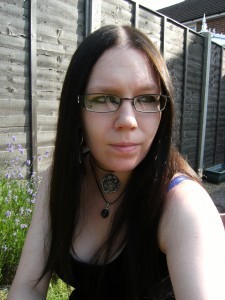 Everyday I’m creating a new story. Even if I’m not writing it down, scribbling a note, typing it up or even sketching its image, my imagination seems to be the driving force behind me. Sometimes I suspect I exist just so it may run rampant. Creativity, be it writing or artwork, is no mere pastime for me, not just a hobby. It is my air. I spend most of my time in a dream, even if I’m just walking down the street.
Everyday I’m creating a new story. Even if I’m not writing it down, scribbling a note, typing it up or even sketching its image, my imagination seems to be the driving force behind me. Sometimes I suspect I exist just so it may run rampant. Creativity, be it writing or artwork, is no mere pastime for me, not just a hobby. It is my air. I spend most of my time in a dream, even if I’m just walking down the street.
There are myriad influences and inspirations in this world around me, and I like to sample from any and all that take my fancy. The most obvious are the media that I enjoy – movies, books, comics, music and even videogames. They all have a story and many also strongly appeal to my very visually stimulated mind. The stories of others will always inspire more story-makers.
The next are my extremely vivid dreams. I used to write a dream diary, although it fell by the wayside in recent months. I’m trying to get back into it, as more meaningful and beautiful dreams creep back to me. Some of my dreams are frightening, many are exciting – a lot are exhilarating. I find them all beautiful. I often recount them to others and people find them profoundly strange, but they all seem just right to me! My fiancé once said that inside my brain naturally occurs a rare, potent and natural form of crack and that’s why my dreams are so damn crazy! So many of them have influenced my creative works, and I feel sad when I go through a period where I don’t have memorable dreams.
One of the other things that sparks off an idea for me is kind of odd. It can be an image; it can be a glimpse of something. It usually has a specific colour. It’s often an aesthetic from another media or something like that, which I then try to recapture and re-imagine. Interestingly, this rarely results in a ‘copycat’, but in something rather different. The story that follows is my interpretation of that colour.
Here are a couple of examples. Once, I saw a trailer for a musical show/DVD, which involved a demonic carnival. It set the ideas spinning in my head, and now I’m working through a plot for a novel that involves a circus of lost souls. However, it barely resembles the plot of the original media (and mine has a particularly clever elephant too!).
‘Skin’, my contribution to Impossible Spaces, began life in a very similar fashion. Last summer, I was shopping in Camden, London, and I happened upon a shop called Psylo clothing. Psylo’s style is very earthy tribal-urban-punk, with a lot of ethnic influences. It contrasts quite sharply with the cyberpunk style that you often also find in Camden, which of course, favours a more synthetic, futuristic look. I started to imagine a science-fiction world in which some people were more organic, and dressed in clothes like the ones Psylo sells, and the others dressed in a more synthetic manner. I had also recently been very intrigued by that summer’s blockbuster Prometheus, and aesthetically was also reminded of the artwork of Michael Turner, particularly in his works Witchblade (which involved a living armour) and Fathom. The Ganyx and the Fetyx began to emerge – the Ganyx were earthy ‘organic’ people who dressed in that tribal-punk look I liked, whereas the Fetyx were pale creatures born into protective but restrictive biomechanical suits. From what started as liking certain fashions, a movie, and some pretty pictures in some graphic novels, emerged ‘Skin’.
Creating these worlds is just something so natural for me. I love the fantasy genre, but I frequently branch out into sci-fi and horror as well – I like my fantasy to have a dark tone to it, rather like the real world in that respect. The stories I end up enjoying the most are the ones I have an emotional attachment to, and I always try to inject something that I know, emotionally, into the story. I feel not only does it breathe a life of its own, but then people are more likely to connect with it also, when there is a small beating heart at its centre. I’m willing to bet some of my work is a little outlandish and crazy, but I’d also like to think that it has some real feeling. Writing is just so important to me that it would be somewhat pointless to write without giving the piece a little love and soul. It can sometimes be hard to share that with others (especially if something you loved then takes a rejection), but, ultimately, finding someone who reads your story or admires your art because they get that emotional essence or connection… that really makes it all worth it.
For more information about Impossible Spaces, or to buy a copy, please visit the publisher’s website.
August 15, 2013
Impossible Spaces and Budget Hotels
“The entrance to the hotel was on one of the city’s less attractive side-streets. Although just a couple of hundred yards from the bohemian quarter in one direction, and a hop, skip and jump from shiny glass coffee shops in the other, the fingerprint-dappled revolving doors themselves sat on an alleyway that was little more than an eight-foot-wide gutter. Underneath the neon blue sign – declaring the hotel’s name in swooping, handwriting-style letters – blank glass windows and brass-effect fittings tried hard to deny the budget accommodation within. Marble flooring inside the doors continued this valiant effort, but was immediately betrayed by the empty space of a torn-out wheelchair lift and a cleaner wiping something sticky off the steps up to reception.
The hotel had three things to recommend it. Firstly, it was located right in the centre of the city and only a couple of minutes’ walk from the station. Secondly, it had a cheap room available at short notice. As she pushed herself through the doors and walked past the ear-budded cleaner on the stairs, Sarah couldn’t for the life of her remember what the third thing was.”
(from my story ‘Great Rates, Central Location’ in Impossible Spaces)
As I’m hosting a few guest posts from the Impossible Spaces writers this month, I thought I should write a little something about my story in the collection and the inspiration behind it.
My story is called ‘Great Rates, Central Location’, and it’s set in a city-centre budget hotel (NB: it is absolutely, positively not based on a real hotel). A young woman checks in to stay at this (not based on a real place) hotel while in town for a business meeting and… well… weird stuff happens. According to one reader, it’s the sort of story that gives you ‘vertigo’.
So: why did I choose to set my story in a budget hotel? There’s a short answer and a long answer to this.
For the short answer, I have to credit horror author Simon Bestwick for the inspiration. In 2012, I was involved in running an event in Manchester that was, with the best will in the world, the stuff of nightmares. Imagine an event where (almost) everything goes wrong, to the point where things are so ludicrous you think you might be hallucinating. And the venue I had (foolishly) chosen was a budget hotel in Manchester. Our list of complaints about the hotel ranged from lack of wheelchair access to clocks that showed 6pm for most of the day before spinning their hands like they were possessed. It was horrific.
But one of the few good things about the event was the group of writers who took part – all of whom dealt with the nightmarish chaos with amazing professionalism. One of these writers was Simon Bestwick, and I’ve been fortunate to keep in contact with him since. He also has a story (the fantastic ‘Trading Flesh’) in Impossible Spaces, as does Richard Freeman who also spoke at the convention. Anyway, a couple of months ago, Simon and I were reminiscing about the horrors of that event and about the venue in particular. Simon suggested that, crap as it was as an event venue, it would make a wonderful setting for a horror story. This made complete sense to me, and kicked off the train of ideas that led to ‘Great Rates, Central Location’ (though my story is not set in that particular hotel, no sir, not at all).
To explain why Simon’s joking comment resonated so strongly with me, I have to give the long answer to the original question.
I love hotels. I think a lot of people do. They’re not just convenient, comfortable, homely (sometimes) places to stay: they’re food for the imagination. I adore TV programmes like Four in a Bed and The Hotel Inspector, and am just as intrigued by the nice places as the only-picked-because-they-make-good-telly establishments. I have to admit: I also love reading reviews on Tripadvisor – even of places I’ll never actually visit. And some of these helped me select details to include in my story (which is not based in a real hotel, so I couldn’t have used reviews of any specific establishment, scout’s honour).
Fiction writers and the tales they weave have a weird relationship with hotels. Take Agatha Christie, for instance. Her detective novels are often set in hotels – this choice of setting is really appropriate for murder mysteries, as it allows a large group of people, who may or may not have a connection to one another, to be brought together and forced into close proximity. Unlike at home, guests at a hotel can hide their identities and their secrets, arrive under assumed names and conduct clandestine affairs. But Christie has another, more personal, connection to hotels – her mysterious disappearance in 1926 culminated in her being discovered at the Swan Hydropathic Hotel (beautiful name) in Harrogate, where she’d registered under an assumed name. What she was doing there remains the only Agatha Christie mystery that has never been solved.
Hotels aren’t just mysterious, though. They can also be horrific. Obviously, no post about hotels and fiction would be complete without mention of Stephen King’s wonderful Overlook Hotel (brought to the screen by Stanley Kubrick), the place where Jack Torrance learned that all work and no play makes Jack a dull boy. And tried to kill his family with an axe. Probably shouldn’t forget the axe part.
The Shining is an almost perfect capturing of the two sides of hotels (certainly as far as writers are concerned). On the one hand, a hotel (especially a closed hotel with no other guests) is a retreat, and we romantically envisage ourselves locked away from the world, with home comforts but no distractions. We imagine sitting at the window (because, in this fantasy, all rooms have views), tapping away at our keyboards, having successfully blocked out our daily lives and mundanity. If we do venture out of the room, we hope it will be to a quirky dining room, filled with a cast of characters we can observe and recreate later in fictional form.
But The Shining reminds us of the fear that lies behind that fantasy. That if we spend too long locked away from our daily lives and mundanity, we might just go absolutely bonkers. Jack’s descent into maniacal rage is wonderfully contrasted with the splendour of the Overlook Hotel, and, in a way, this just seems to add to the wildness of his story.
Of course, my story isn’t set in a grand old hotel like the ones you find in Agatha Christie or Stephen King. It’s set in a slightly shoddy, slightly grimy budget hotel, where some of the rooms don’t have windows and the staff don’t really care. The sort of place where you’re not completely comfortable using the bathroom and there are strange yells during the night. (Not that it’s based on any real hotel, of course.)
I travel a lot at the moment, mostly to attend conferences and events, and I don’t have enough money to stay in places like the Overlook Hotel or the Old Swan in Harrogate every time I go away. I stay in B & Bs or budget hotels. And I’ve had a range of experiences, from the sublime to the ridiculous, as a result.
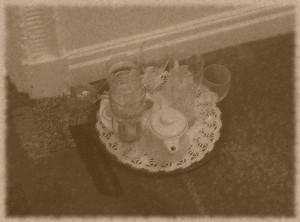 One place I stayed in – an establishment that smelt, it has to be said, entirely of egg – was run by a strange man who shuffled around in a dirty jumper and tatty slippers, and who kept talking about his mother. But there was no mother to be seen. It was like staying at a cross between the Bates Motel and a house that smelt entirely of egg.
One place I stayed in – an establishment that smelt, it has to be said, entirely of egg – was run by a strange man who shuffled around in a dirty jumper and tatty slippers, and who kept talking about his mother. But there was no mother to be seen. It was like staying at a cross between the Bates Motel and a house that smelt entirely of egg.
Another place offered a ‘colour television’ in all rooms (as though a less luxurious black-and-white option might be offered elsewhere). There was indeed a TV in my room, but the batteries in the remote control had long since corroded so I couldn’t switch it on.
And I stayed in one budget hotel in London where my room had no number, and only fit a bed that looked to have been hastily squeezed in there. I think the room had been a cupboard up until I arrived. Everything at that hotel was filthy, and the staff all looked so hopelessly forlorn it broke my heart. The ‘continental breakfast’ was a plate with two slices of white bread, two slices of ham and a Dairylea triangle (covered over with cling-film).
I might sound like I’m complaining about these places, but I actually love them. Okay… I did feel a little scared at the eggy Bates Motel place, and I once spent a morning vomiting after eating the cooked breakfast at a budget (chain) hotel. But when it comes to creative inspiration, I find these places utterly enthralling. Forget big rambling grand old houses with waistcoated bellhops and aloof receptionists. Getting lost in a seven-storey chain hotel while looking for a vending machine is the stuff of genuine nightmares.
I have stayed in some lovely places. I stayed in a wonderful B & B in Cork once that was one of the warmest, friendliest places I’ve ever been. And my other half and I love the little B & B we stay in when we make our annual trips to Whitby.
But it’s the blank-eyed, don’t-care, bad-breakfast, curtains-that-don’t-shut-properly aura of the budget hotel that inspires my writing. This isn’t horror in the overblown, Gothic sense, but a more banal, insidious claustrophobia. Some people might describe budget hotels as soulless – I disagree. These places definitely have a soul, but that soul is worn down, broken and twisted. And I love them for that.
So, that’s the inspiration for ‘Great Rates, Central Location’. I hope you’ll check my story out, along with the other fab stories in Impossible Spaces. And I hope you think I’ve done justice to my grotty little budget muses.

